Many of our clients will often ask us what the right pour size is for liquor drinks. While we’d love to reply with an iron-clad answer, the truth is that there is no one “right” pour size for the drinks you serve. As with pricing decisions, you must be strategic with your pour sizes to ensure they reflect the unique needs of your bar and clientele.
While some countries such as Great Britain mandate specific pour sizes for their drinks, the United States doesn’t have these types of regulations in place. This gives bars a lot more flexibility, but it also makes the process of setting pour sizes at your bar more complicated.
The good news is that if you’re smart about your pour sizes, you have an opportunity to differentiate your bar from your competitors, and you can more effectively cater to the preferences of your customers.
What are the Most Common Pour Sizes for Liquor Drinks?
Most states in the country, including our home state of Colorado, consider 1.25 oz. to be a “liquor serving.” However, this doesn’t necessarily mean that 1.25 oz. is the most common pour size for cocktails.
 At least 80% of Bar-i’s clients across 20 different states use 1.5 oz. as their standard serving size, and we tend to feel that this is generally the ideal pour size for most bars. Using a 1.5 oz. pour size lets you serve a slightly more substantial drink while maintaining a solid level of profitability.
At least 80% of Bar-i’s clients across 20 different states use 1.5 oz. as their standard serving size, and we tend to feel that this is generally the ideal pour size for most bars. Using a 1.5 oz. pour size lets you serve a slightly more substantial drink while maintaining a solid level of profitability.
The 1.25 oz. pour size is most typically found at corporate establishments and franchise chains. These bars and restaurants are typically hyper-focused on profitability, and using a smaller pour size will help them maximize their profits. The downside to serving a 1.25 oz. drink instead of a 1.5 oz. drink is that it provides less value to the customer. For many independently owned bars, providing this extra value is crucial to generating business, making a 1.5 oz. pour size a better choice.
While 1.25 oz. and 1.5 oz. are the two most standard pour sizes, there are some outliers to this rule:
- Many Las Vegas casinos and bars will use a 1 oz. pour. This is definitely getting to be on the skimpy side for a cocktail and should be considered the absolute low end for what could be considered acceptable.
However, the value provided at Vegas establishments generally revolves around gambling or entertainment, and not the drinks being served. Therefore, a 1 oz. pour isn’t as problematic in these places as it would be at most bars. - Higher-end establishments such as expensive restaurants and fancy hotels will sometimes serve 2 oz. cocktails. This pour size tends to be a good fit for very high-end establishments because their clientele isn’t as concerned about cost and will be open to paying a little extra for a quality drink prepared the right way. In these situations, offering a larger pour size provides the type of value their customers are looking for.
Avoid a Pour Size Larger than 2 Ounces
Anything above a 2 oz. pour size is problematic for two reasons:
- Greater risk of overserving
- Inability to set a competitive price for your drinks
The risk of overserving is somewhat obvious. If you have a 2.5 oz. pour size, your customers are receiving much more than a standard cocktail. Two 2.5 oz. drinks (5 oz. of liquor) would equate to:
- Over 3 full drinks at a 1.5 oz. pour size (3 drinks = 4.5 oz. of liquor)
- 4 full drinks at a 1.25 oz. pour size (4 drinks = 5 oz. of liquor)
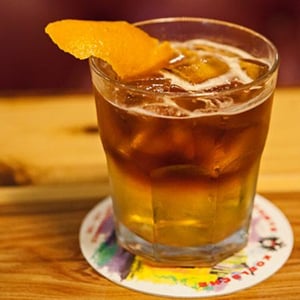 In the customer’s mind, only two drinks were consumed. However, the truth is quite different. If you extrapolate this disparity, a customer who orders 3 or 4 drinks at a 2.5 oz. serving will easily end up wasted.
In the customer’s mind, only two drinks were consumed. However, the truth is quite different. If you extrapolate this disparity, a customer who orders 3 or 4 drinks at a 2.5 oz. serving will easily end up wasted.
However, the more important issue has to do with the way you will have to price these larger drinks. If most bars in town are selling a 1.5 oz. Jack and Coke for $6 and you’re serving a 2.5 oz. pour, you’re adding 67% more alcohol to your drink than most bars are putting in their Jack and Coke.
In order to maintain the same liquor cost as these other establishments, you’d have to price your Jack and Coke at $10 (which equates to a 67% higher price for 67% more alcohol). It’ll be very hard to communicate to customers that your $10 Jack and Coke is actually the same price as the $6 Jack and Coke served at other bars once you account for the differences in pour size. Therefore, you’re more likely to be perceived as being more expensive than your competitors, and many customers will likely go to another bar where they can get a more traditionally priced drink.
The Type of Value You Want to Provide should Guide Pour Size Decisions
Unless you’re running a Vegas casino or a very high-end establishment, you’re most likely choosing between a 1.25 oz. pour size and a 1.5 oz. pour size. So which option is right for your bar? The answer will largely depend on the type of value you’re looking to provide to your customers.
The Case for a 1.25 oz. Pour Size
The benefit of choosing a 1.25 oz. pour size is that it enables you to price your drinks more competitively. If most of the other bars in your area offer 1.5 oz. Jack and Coke for $6, you can price your 1.25 oz. Jack and Coke at $5 and maintain the same liquor cost.
Consider the math involved (I know we’re not supposed to have to do math at bars, but just follow along for a moment):
- A 1.5 oz. Jack and Coke that costs $6 equates to $1 per quarter ounce of liquor
- If you reduce your pour size to 1.25 oz., you can now charge $5 for the drink and still maintain that $1 per quarter ounce cost
A cost-conscious customer may potentially be more likely to go to a bar charging $5 for their Jack and Coke than a bar charging $6. Therefore, if you have a cost-conscious clientele, the perception of value may drive traffic to your bar even though your competitors are providing the same value at a different pour size.
Takeaway: If you are trying to differentiate yourself from your competitors based on price, choosing a 1.25 oz. serving size will enable you to undercut the prices charged by your competitors serving a larger portion size.
The Case for a 1.5 oz. Pour Size
If most of your competitors are corporate establishments that use a 1.25 oz. pour size, you may want to consider making 1.5 oz. your standard pour size. This will help you differentiate yourself from your competitors by providing stronger drinks.
In this situation, you will definitely want to promote this difference so that your customers understand the value they’re getting (a heavier pour) when they drink at your bar.
Of course, these aren’t the only two ways to provide value that differentiates your bar from your competitors. Your bar may have a fun atmosphere, friendly staff, good live music, lots of TVs for sports or a great outdoor patio. All of these things provide value that may entice customers to come to your bar even though your 1.5 oz. pour size and the price of your drinks is identical to what customers will find if they visit your competitors.
Pour Size Considerations for Shots
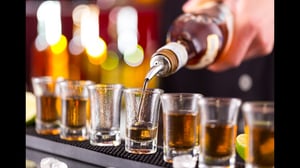 The typical range for shot sizes is 1 oz. to 1.5 oz. There are several ways you can approach determining the standard shot size at your bar:
The typical range for shot sizes is 1 oz. to 1.5 oz. There are several ways you can approach determining the standard shot size at your bar:
- If you have a 1.5 oz. pour size for cocktails, you can keep things simple and do a 1.5 oz. shot size as well. This allows you to price your shots and drinks for a given type of liquor the same way.
- You can also choose a smaller 1 oz. pour size for your shots, which allows you to price your shots lower than your cocktails. In this situation, you can make the same profit margin on each drink if you charge $6 for a 1.5 oz. Jack and Coke and $4 for a 1 oz. shot of Jack Daniels.
You can also boost your profit margin on shots by pricing your 1 oz. shot of Jack Daniels at $5. This will still encourage customers to buy the shot since it’s cheaper than the cocktail, but the amount being charged per quarter ounce of liquor is higher than on the cocktail.
Bar-i typically recommends 1 oz. shot sizes. We feel it is the smarter pour size for shots for several reasons:
- It reduces overserving – Shots are a social drink. People will usually get a round of shots for everyone in the group. These drinks are a great way to increase your check size since a round of shots can be consumed immediately whereas another round of beers will take much longer to finish. At a 1 oz. pour size, that “shot for the road” won’t get your customers as drunk before they leave the bar. This effect is compounded if a group orders several shots throughout the night.
- It forces you to price shots differently than cocktails – Charging less for a shot than for a cocktail will often entice customers to buy shots, which will raise your check size and boost your profits.
Regardless of the shot size you choose, Bar-i recommends adhering to one of the following rules:
- Same size/same price as your cocktails
- Different size/different price than your cocktails
If shots are priced and sized differently than cocktails, it provides a built-in system to keep your bar staff honest. Your customers know that shots are cheaper, which makes it much harder for bartenders to pour a shot and ring it in as a cocktail. If you make your shots a smaller size and charge the same price as a cocktail, it makes you more vulnerable to having drinks given away.
For example, if the price of a shot and a cocktail are both $6, but there is a 1 oz. shot size and a 1.5 oz. cocktail size, your bartender can ring in 2 shots as cocktails. The price would be the same so your customer wouldn’t notice. However, your POS system would record 3 ounces of liquor being served instead of 2 ounces. This would allow your bartender to give away a free shot later in the night and your POS system would still recognize the right amount of alcohol being served.
This potential issue is avoided by adhering to either the same size/same price rule or the different size/different price rule.
Pour Size Considerations for Rocks Drinks
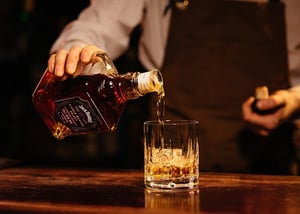 Rocks drinks are typically a 2 oz. pour. If you have a 1.25 oz. pour size, this will equate to a .75 oz. bump from your standard drink. If you have a 1.5 oz. pour size, it will only result in a .5 oz. bump from your standard drink.
Rocks drinks are typically a 2 oz. pour. If you have a 1.25 oz. pour size, this will equate to a .75 oz. bump from your standard drink. If you have a 1.5 oz. pour size, it will only result in a .5 oz. bump from your standard drink.
It doesn’t really matter how much extra alcohol is added to your rocks pour compared to your standard pour as long as you charge accordingly for this increase. The way to ensure that rocks drinks are being priced properly is to set up your POS system correctly.
If you use a generic “rocks” modifier that charges $2 for every rocks drink, you’re using the same upcharge for well vodka as you are for Johnny Walker Blue. That’s not smart, and it will cost you a lot of money in the long run if you sell a lot of high end rocks drinks. You need to build out your modifier buttons so that every drink has its own button. This will ensure that higher end liquors have a larger upcharge for rocks drinks than well liquors have.
Pour Size Considerations for Doubles
This one is fairly easy to figure out. Doubles are typically twice the size of a standard drink:
- If you use a 1.25 oz. pour size, a double will be 2.5 oz.
- If you use a 1.5 oz. pour size, a double will be 3 oz.
Strategic pricing for your doubles may encourage higher checks. Doubles typically cost twice as much as a standard sized drink, but you may want to price your double more aggressively to encourage people to order them, which will ultimately lead to higher checks. This may raise your liquor cost slightly, but you’ll also bring in more profits than you would if a customer was ordering a standard sized drink all night.
Keep in mind that these strategic pricing decisions should be balanced with the need to prevent overserving.
Pour Size Considerations for Martinis
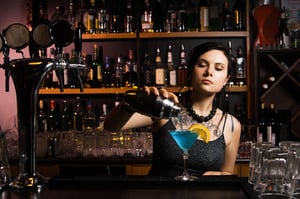 The problem with pour sizes for martinis often relates to using a glass that is too large. If you have a 7 oz. martini glass, it will look bad if you have anything less than 5 oz. of liquid in the glass. Even if you’re able to get a small amount of shake from melted water, you’re still putting a lot of liquor in your martinis to get 5 oz. of liquid.
The problem with pour sizes for martinis often relates to using a glass that is too large. If you have a 7 oz. martini glass, it will look bad if you have anything less than 5 oz. of liquid in the glass. Even if you’re able to get a small amount of shake from melted water, you’re still putting a lot of liquor in your martinis to get 5 oz. of liquid.
If you need to put more than a double into your martini glass to make the drink look good, it will be impossible to charge enough for this drink to make a decent profit. This is especially true when you consider the fact that martinis are typically made with mid-range or high-end liquors.
For this reason, Bar-I recommends that you max out your pour size for martinis at a double. You’ll need to make sure that you have the right sized glass to make the drink look good. This will allow you to price your martinis in a manner that yields a decent profit.
Pour Size Considerations for Signature Drinks
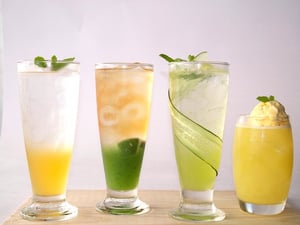 There tends to be a bit more variability in the sizes of signature drinks since these cocktails are specific to the bar that makes them.
There tends to be a bit more variability in the sizes of signature drinks since these cocktails are specific to the bar that makes them.
The following tips will help you set appropriate pour sizes on your signature drinks:
- Focus on taste – Since all of these drinks are unique, there can’t be a set amount of liquor used in all signature drinks. Instead, you should choose a pour size that makes sense for each specific drink. This size should be based on what will make for a great tasting drink.
- Be consistent – Make sure every drink is made with the correct proportion of ingredients so that your signature drinks always have the same great taste. You may want to consider requiring your bartenders to use jiggers when making these drinks to maintain this consistency.
- Consider the price of the drink – Just as with martinis, using too much liquor in a signature drink will prevent you from making a profit. Make sure you choose a portion size that will allow you to charge enough money to make a good profit while still enticing customers to order the drink.
Determining the Right Pour Size for Your Bar
There are pros and cons to every approach discussed above. Ultimately, it’s up to you to think about which of these approaches makes the most sense at your bar. The most important thing is to discuss your pour size strategies as a team with all owners and managers. Once you make a decision as a group, you need to be consistent and make sure all drinks are poured properly.
Agreeing on a standard size and being consistent with your pours is more important than the actual pour size you arrive at.
In order to be consistent, you’ll need to communicate this new standard pour size to your staff. However, it’s not enough to relay this information to your staff. You must also take the steps necessary to make sure your employees are adhering to the standard pour sizes established by the management team.
In order to verify that drinks are consistently being poured correctly, you will need to use a sophisticated inventory system that compares what was poured vs. sold. If you don’t take this important step, you run the risk that drinks will be overpoured. Bar-i’s inventory system will provide you with the precise data necessary to make sure your drinks are consistently being poured correctly.
If you’d like to learn more about how Bar-i can help streamline your processes and maximize profits, please contact us today to schedule a free consultation. We serve bars nationwide from our offices in Denver, Colorado.


-1.png)